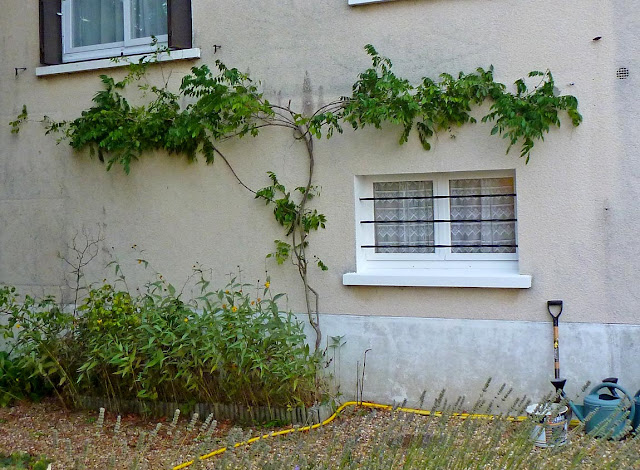Here's what I did with those little tomatoes Walt showed a picture of yesterday in his blog post. By the way, those particular tomato plants were volunteers. They just came up, and we just let them grow, without really tending them.
I ended up with two trays of tomato halves like these.
They're called Juliets, and they're larger than cherry tomatoes but a lot smaller than Roma tomatoes, which they resemble. The scientific name is Lycopersicon esculentum 'Juliet' and you can find a lot of sites of the web with information about the variety.
These have been drying for an hour or two.
To dry them, I cut each little tomato in half the long way and arranged the halves on oven trays lined with parchment paper (papier de cuisson). I put them in the oven at about 200ºF / 90ºC for several hours, watching them to make sure they were drying and not burning. I use a convection oven.
The two trays of tomato halves produced this amount
after drying for hours in a low oven.
after drying for hours in a low oven.
The idea is to dry the tomatoes without cooking them, so it's important to keep them below the boiling point. Lower the heat as necessary while they are cooking to get the result you want, and leave the tomatoes in the oven after you turn it off to let them cool down slowly and continue drying. I left them in the oven overnight.
These are dried as much as I wanted them to be dried —
they're still slightly moelleux (tender).
they're still slightly moelleux (tender).
Today I'll put the dried tomatoes in jars and heat the jars up in the oven to near 100ºC (the boiling point) before putting the lids on. Then I can keep them in the downstairs pantry over the winter.
* * *
A couple of days ago, we put the wisteria plant (glycine) back up on the wall of the house. It had blown down in a storm — one of the support wires broke under the weight of the plant's plentiful, wet leaves.
Avant
Après
Walt put up a new, heavier-gauge support wire. Putting the plant back up was an opportunity to prune it back pretty severely. Above are two pictures, before and after the fall, as it were, and the pruning. So that all worked out.







Ken - here in Melbourne the wisteria is welcoming in Spring - purple everywhere and soon the Jacaranda will start blooming. I can see new growth on ours as I sit typing in the Study.
ReplyDeleteTwo thumbs up!
ReplyDeleteJudy
Your wisteria looks better now. I love it in the Spring, but it can be a real nuisance when it grows too large.
ReplyDeleteI hope that your heavy-duty wire will be enough to support the Wisteria. My horticulture prof used photos of examples where simple fences or 4x4 posts were attempting to support the vines. He used photos of the Chicago Botanical Garden's 6x6 wood posts and perhaps even larger columns that supported theirs. He said and I have seen some of the thickly developed roots that Wisteria can grow! Looks very nice what you have done. I'm glad you could save it.
ReplyDeleteThe tomatoes look so good and I was pleased to read about putting the filled open jars in the oven for a second drying out. When I dried tomatoes the first time in my dehydrator, I hadn't gotten them completely dried. They were fine that summer on a camping trip but later in the fall when I went to use them they had developed mold. Too bad I wasn't reading your blog then, Ken!
Mary, the same thing happened with the first tomatoes I dried a few years ago. That's why I started re-heating them in the jar before putting the lid on. It seems to work.
ReplyDeleteI think the secret to the wisteria is to be vigilant about pruning it every year so it doesn't get too heavy. And maybe we'll have to built some kind of wood support posts or trellis for it down the road.